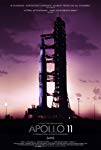Eye For Film >> Movies >> Apollo 11 (2019) Film Review
Apollo 11
Reviewed by: Owen Van Spall

In our year of 2019, what more could be said on film about the American Apollo 11 space mission, which successfully placed commander Neil Armstrong and pilots Buzz Aldrin and Michael Collins into orbit around the moon in late July 1969, and all but the latter astronaut on the surface of our nearest planet?
There is no shortage of documentaries and ‘docufictions’ about the space race, after all, and Ron Howard’s dramatisation Apollo 13 showed what digital effects could do to visualise the nature of space travel from that era. Well, with this new doc, director Todd Miller hasn’t mustered any new information about the events, the technology or the politics of the Apollo programme that I didn’t already know. What he has done, however, is find a vibrant new way to show us the visual chronology of the launch, landing and recovery of the Apollo 11 mission.
In an era of cynicism about the truth behind the visual image, and fear that advanced societies like that in the United States are no longer able to cohere around large-scale projects, such as fighting climate change or inequality, the clarity of the images assembled here from the NASA archives by Miller and his team, as they retell the dramatic journey of those three moon-men in July 1969, cuts through and forcefully imprint on us that this HAPPENED. People built that massive Saturn rocket, designed fragile but capable craft like the lunar module which made it down from the mothership to an uncharted rocky surface, and crunched the numbers behind the scenes to ensure all this pioneering and potentially lethal technology could be steered in the right direction. If you are going to craft an uplifting message, it helps to have visuals that, well, uplift.
Using only archive footage from 1969 and the bare minimum of online text and graphics, Miller’s film tells its story cleanly and competently, laying out in chronological order from two hours to launch to the days after splashdown how Apollo 11 played out. The events of 16 July 1969 – 24 July 1969 are compressed reasonably well, with some handy contemporary diagrams inserted here and there to run us through the physics of space travel and the key manoeuvres necessary to get the unwieldy and explosive fuel-laden Saturn rocket off Earth, out of our atmosphere and orbit, and into the Moon’s gravitational pull before sling-shotting around again for home. Still, audiences not familiar with NASA tech-speak might struggle a little given the complexity of the physics and the fact this newly-synced audio was recorded over 1960s-era microphones; it is a little muffled in places.
The scale of the achievement is nevertheless transmitted clearly - as are the risks of the time - but Miller manages to do more than just feed you the Wikipedia page. Despite knowing, thanks to the consumption of a dozen or so books on the moon landing, how things would play out to the hour, even the second, I still found myself tensing up when we see the Eagle lunar lander begin its descent; Miller letting the footage and synced audio captured in the interior of the lander play uninterrupted with a small onscreen counter listing out the speed and fuel remaining. This neatly puts us in the shoes of the NASA staff back on Earth, who would have had to judge the moon landing success by this kind of data rather than images. Armstrong - who piloted the lander - was cutting it close.
But Miller’s real ace in the hole is the quality of the footage and audio he has dug up from NASA’s vaults, much of it being seen for the first time. Alongside 16 and 35mm film, Miller found spectacular 70mm film footage of the launch and recovery stages of the Apollo 11 rocket, which both ground and helicopter camera teams had shot. This footage, captured on the kinds of film that IMAX uses today, is nothing short of stunning; effective at both conveying the awesome scale of the rocket technology as it sits smouldering on the launch pad framed against the blue sky like a coiled beast, but also at vividly showcasing the look and feel of America in the late Sixties.
With NASA’s film crews ordered to shoot miles of footage even before the rocket took off from Cape Canaveral in sunny Florida, the meandering cameras in the space centre had plenty of time to capture the cross-section of America that crowded into the designated viewing areas to watch the launch take place: expect chrome-laced cars, giant sunglasses, punchy miniskirts and lots of beehive hairdos. The 70mm footage includes the launch itself, a visual and aural experience so awe-inspiring it puts the centrepiece moment from Ron Howard’s Apollo 13 in the shade. The visual material that covers the actual mission pre-splashdown perhaps doesn’t quite live up to what preceded it, given space doesn’t provide a compelling visual backdrop (there are no visible star fields, something ‘hard' sci-fi cinema has always felt the need to compromise on) and cramped spacecraft interiors don’t allow for dynamic camera shots or 70mm cameras, but the conversation of the astronauts punctuates each stage of the mission with lightness and charm, and you there is some fun to be had listening to (and trying to translate into layman)the ritualistic tech jargon they spout. Go see this in IMAX, if you can.
Reviewed on: 30 May 2019


















